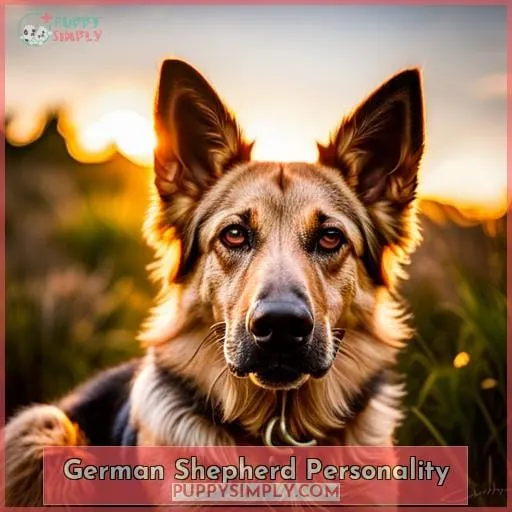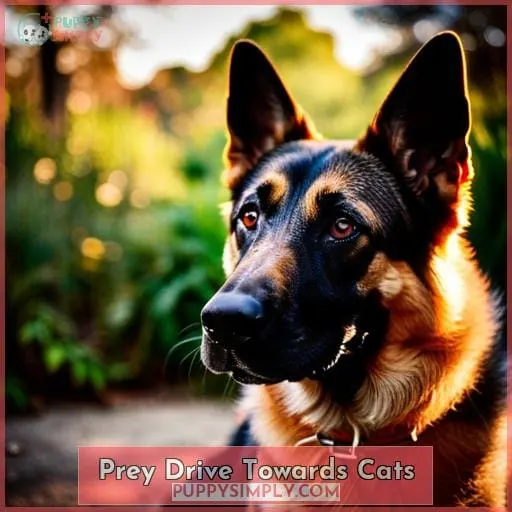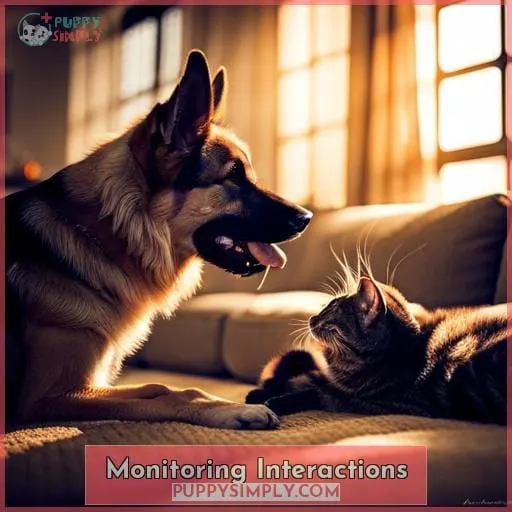This site is supported by our readers. We may earn a commission, at no cost to you, if you purchase through links.
 They say cats and dogs don’t mix, but that’s not always true.
They say cats and dogs don’t mix, but that’s not always true.
As an ardent admirer of German Shepherds, I’ve seen these perceptive pups forge friendships with felines when socialized young.
However, without proper precautions, what begins as harmless herding can lead to harmful hunting between Shepherd and Siamese.
Alas, coexistence relies not on breed, but the individual bond built between dog and cat through compassionate conditioning.
So, can German Shepherds get along with cats?
Let’s unravel the intricacies of this nuanced relationship.
Table Of Contents
- Key Takeaways
- German Shepherd Personality
- Prey Drive Towards Cats
- Spaying/Neutering Effects
- Introducing a Puppy to Cats
- Introducing an Adult Dog to Cats
- Bringing a New Cat Into the Home
- Tips for Coexistence
- Monitoring Interactions
- Benefits of Harmony
- Is It Possible?
- Frequently Asked Questions (FAQs)
- How do I know if my German Shepherd has a high or low prey drive?
- What are some other factors that can influence how my German Shepherd will react to cats?
- How old should my German Shepherd be before I introduce them to a cat?
- What are some signs that my German Shepherd is feeling stressed or anxious around cats?
- What are some things I can do to help my German Shepherd and cat get along better?
- Conclusion
Key Takeaways
- German Shepherds have a strong prey drive toward cats that needs to be managed through training and techniques like leave it lessons.
- When introducing a German Shepherd puppy to cats, let them get used to each other’s scents first, then gradually increase supervised time together.
- With an adult German Shepherd, begin with supervised interactions after obedience training. Use positive reinforcement to curb prey drive. Slowly increase time spent together.
- During supervised interactions between German Shepherds and cats, reward calm interactions, keep sessions short initially, praise good behavior, and watch for stress signals like hackles raised.
German Shepherd Personality
One characteristic of the German Shepherd breed is their strong prey drive, which can make coexisting with cats challenging.
As loyal companions bred for obedience, German Shepherds thrive with training and socialization techniques focused on proper behavior around felines.
Without it, their energetic temperament paired with high intelligence can lead them to view cats as something to herd or chase.
However, with effort on the human’s part and controlled interactions, German Shepherds can learn to live peaceably with cats.
Setting boundaries, providing stimulation, and establishing yourself as the pack leader are keys to curbing negative behavioral challenges.
With time, patience, and the right methods, their natural protectiveness and affection for their family can extend to cat housemates as well.
Prey Drive Towards Cats
Many German Shepherds have a strong prey drive toward cats that you’re going to need to manage if you want them to coexist peacefully.
That instinct to chase small furry things like cats is deeply ingrained in breeds like German Shepherds that were originally bred to herd animals.
With proper training and techniques though, you can teach your Shepherd to control their impulses and leave kitty alone.
Start with leave it lessons using toys or treats and work your way up to supervised interactions with cats.
Train impulse control through techniques like wait and zoo walking.
With enough repetition and positive reinforcement, you’ll be able to get your dog’s predatory behavior under control so they can learn to peacefully coexist with felines in the home.
Spaying/Neutering Effects
Spaying or neutering your German Shepherd can reduce its prey drive and make it easier to get along with cats.
The removal of key sex hormones through this procedure often leads to calmer, less aggressive tendencies in dogs.
With their raging instincts dampened, they become more amenable to cohabitation with different species.
For high-drive German Shepherds, this can significantly impact their behavior towards smaller pets like cats.
The health benefits of spay/neuter also contribute to mellower dispositions.
With less pent up energy and frustration, they’re less likely to fixate on cats as prey.
While individual temperament plays a role, the hormonal influences of spay/neuter can give you a head start on cat-dog harmony by reducing those ingrained prey drives.
Introducing a Puppy to Cats
When bringing home a German Shepherd puppy, introducing them to the feline members of your family requires patience and a slow, methodical approach.
Start by letting the puppy and cats get used to each other’s scents before they actually meet.
Give them positive reinforcement with treats and praise for calm behavior during brief, structured interactions.
As they build confidence, gradually increase the time they spend together under supervision.
Always have an escape route for the cats and don’t allow chasing.
With plenty of breaks and their own spaces, they’ll adjust to coexisting with time.
Introducing an Adult Dog to Cats
When bringing an adult German Shepherd into a home with cats, training should come first.
Start with supervised interactions so you can interrupt any chasing behaviors before they escalate.
This will help the dog and cats safely get used to each other’s presence.
Training First
Having introduced your new puppy to the cats, now focus on training your adult German Shepherd before interactions with felines.
Reinforce basic obedience, like sit, stay, and leave it, using positive reinforcement to curb prey drive and set boundaries around cats.
With consistent commands, patience building, early socialization techniques, and obedience training, you can teach even herding breeds to get along with feline housemates through understanding the motivations and instincts driving their behavior.
Supervised Interactions
After training your adult German Shepherd, you’re ready to start introducing them to the cats under supervision.
Reward calm interactions during playtime.
Keep interactions brief at first to respect boundaries.
Ensure training techniques remain consistent.
Praise good behavior; don’t punish bad.
Watch for stress signals like hackles raised.
Bringing a New Cat Into the Home
When bringing a new cat into a home with an existing German Shepherd, go slow and be strategic.
Start by keeping kitty confined to a safe room, like a bathroom or spare bedroom. This allows your dog to become accustomed to the new smells and sounds before meeting face-to-face.
When you do allow initial interactions, supervise closely. Provide your dog with lots of praise and treats for calm, polite behavior around the cat.
With time, patience, and positive reinforcement, gradually increase the time they spend together.
With proper precautions, even high prey drive dogs and cats can learn to coexist peacefully.
Tips for Coexistence
You’ll want to follow some key tips for helping your German shepherd and cat coexist peacefully:
Use training techniques like positive reinforcement to teach your dog to ignore the cat.
Give your pets their own safe spaces. Use baby gates to separate them when unsupervised.
Introduce them gradually and in a controlled way. Let them become accustomed to each other’s smells first.
Implementing these practical methods will help your strong-willed herding dog and independent feline adjust to cohabiting.
Consistency is key – be vigilant and don’t give up!
Monitoring Interactions
How frequently can you check on your German Shepherd and cat when you first introduce them?
It’s ideal to observe their interactions for at least short bursts every 10-15 minutes at first.
Focus on behavior patterns like play bowing, hissing, swatting, stiffening up, or chasing to gauge comfort levels.
Watch for warning signs from either animal like pinned ears, growling, or aggressive body language.
If you notice these, intervene with gentle distraction and praise good behavior.
You want to reinforce amicable actions while also ensuring both pets feel safe.
Frequently monitoring their body language helps you promote positive relationships and harmony in your home.
With keen observation and patience during initial coexistence, your Shepherd and cat can learn to get along.
Benefits of Harmony
You’re considering adding a cat to your German Shepherd’s home.
While challenging, harmony between these instincts-driven animals is possible and brings many benefits.
Reduced tension, a healthier home environment, more affectionate pets with improved behavior, and less fighting should motivate you to thoughtfully introduce them.
Reduced Tension
A consistent record of harmonious behaviors between your German Shepherd and cat will lower tensions between the pets.
You’ll notice less apprehension and more comfort as they acclimate to sharing space.
Through understanding cues, gradual exposure, positive reinforcement, establishing safe spaces, and exercising patience and consistency, the natural tensions between a herding dog like a German Shepherd and a feline housemate can be reduced over time.
Healthier Home
With properly managed coexistence between cats and German Shepherds, you’ll find the home becomes healthier for everyone.
Reduced stress and anxiousness lead to more relaxed pets.
Ensuring proper nutrition, exercise, environmental enrichment, and managing interactions lets both species thrive together.
This reduces territorial behavior while encouraging affection and play.
Simple steps create a more harmonious home.
More Affectionate Pets
When your pets get along well, their affection for you grows as tensions ease between them:
- Increased bonding with owner.
- Emotional connections deepen.
- More affectionate gestures like cuddling.
- Benefits from companionship with each other.
Improved Behavior
Often, when cats and German Shepherds learn to get along, you’ll see an improvement in their behavior.
With behavioral training focused on positive reinforcement and setting consistent rules, both species can better understand expectations for peaceful coexistence.
This socialization establishes cat-friendly spaces where your eager-to-please companion embraces new guidelines for improved behavior around felines.
| Behavior | German Shepherd | Cat |
|---|---|---|
| Anxious | Pacing, whining | Hissing, swatting |
| Content | Relaxed posture, gentle wagging | Purring, kneading |
| Aggressive | Baring teeth, tense posture | Arching back, ears back |
Less Fighting
You’ll experience fewer fights and aggression issues between your German Shepherd and cats when there’s harmony in your multicat, multidog household.
Fostering peaceful coexistence through training, supervision, and environmental management will minimize conflicts and reduce tension.
Focused harmony techniques like positive reinforcement, separating animals when unsupervised, and scent familiarization promote better relationship dynamics for less stress and fighting.
Is It Possible?
Through following the tips outlined above, you’re able to foster harmony between your German Shepherd and cats.
With proper training techniques focused on impulse control, behavioral adjustments through positive reinforcement, slow and intentional socialization methods, and environmental enrichment strategies, coexistence is possible for this challenging duo.
Pay close attention to body language, create plenty of vertical territory using cat trees, and provide separate spaces for alone time.
Use treats, toys, and play to encourage positive interactions.
It takes patience, vigilance, and an understanding of natural instincts, but with consistent effort, you can facilitate interspecies communication and friendship.
An enriched home where all pets feel safe and secure leads to reduced tension, healthier animals, more affectionate behavior, and improved quality of life for the entire household.
Frequently Asked Questions (FAQs)
How do I know if my German Shepherd has a high or low prey drive?
Observe your German Shepherd’s interactions with other animals, especially small, furry ones.
A high prey drive may manifest as intense chasing, barking, or even aggression toward cats or squirrels.
What are some other factors that can influence how my German Shepherd will react to cats?
There are many factors to consider beyond prey drive.
Your Shepherd’s early life experiences with cats, parentage and breeding, and individual personality including confidence, curiosity, and excitability also shape its tendency to get along well with cats or perceive them as prey.
Regular positive interactions from puppyhood fostered in a calm environment create the best results.
How old should my German Shepherd be before I introduce them to a cat?
Introduce them when your German Shepherd is old enough to understand the concept of gentle and respect boundaries.
Good luck with that!
What are some signs that my German Shepherd is feeling stressed or anxious around cats?
Excessive barking, hackles raised, tense body posture, avoiding eye contact, lip licking or yawning, hiding behind you, snapping or lunging attempts.
Continue supervising interactions and provide positive reinforcement for calm behavior.
What are some things I can do to help my German Shepherd and cat get along better?
You can’t make your German Shepherd like your cat,
but you can take measures to promote harmonious coexistence.
Provide spaces for them to safely retreat when needed.
Reward calm interactions.
Never force contact.
Meet their species-specific needs for mental stimulation and exercise to curb problematic chasing.
Patience and time may ease tensions.
Conclusion
As intertwined as cats and dogs, harmony hinges on compassion.
Like shepherds guiding flocks, consistency and patience lead this challenging duo through tensions into affection’s pasture.
Ultimately, coexistence relies not on breed but the individual bond built between dog and cat.
With proper precautions, supervised interactions, and monitoring, even shepherds and Siamese can form rewarding, lifelong friendships.
















